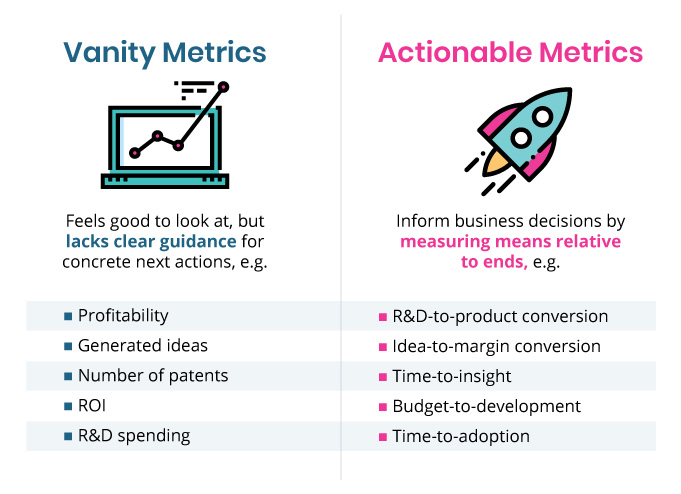The relevance of profitable innovation activities is obvious: With emerging technologies – such as AI - companies need to keep track of their innovation activities and targets in order to prevail against the competition. When discussions turn to the immediate financial impact, even the most robust innovation activities are quickly undone. Thus, it requires innovation metrics that are actionable, informative, and measurable to steer innovation activities towards desired future goals.
In this article, we provide you with a better understanding of the key innovation metrics that take strategy, organization, culture, and operation into account, and introduce you to the tools you need to feed and transform your innovation KPIs so they better represent progress towards your innovation targets.
The Well-Known Vanity Metrics
Let's first get an understanding of the two different approaches that can be taken when tracking innovation metrics: vanity or action.
The vanity metrics are popular, but not necessarily beneficial. They focus on the current impact, neglecting possibilities in the future. Commonly they keep track of:
- Profitability
- Generated ideas
- Number of patents
- Return on investment (ROI)
- Research & development (R&D) spending
Vanity metrics create feelings of comfort but lack concrete next steps to act upon. Instead of paving a path through the jungle of possibilities, they merely show the status quo. For this reason, it is more effective to use a different type of metrics that are actionable, informative, and measurable.

Actionable KPIs Steer Innovation Activities
Actionable metrics can result in informed business decisions and subsequent action. Actionable KPIs are characterized as:
- Relative (input/output) and time-bound
- Related to specific goals and having a motivation
- Revealing possible directions for change
However, many organizations fear to use innovation KPIs because they do not want to limit creativity or use vanity metrics for the sake of simplicity. The downside of vanity metrics is their merely look good on paper. In contrast, actionable metrics relate input and output factors and provide concrete indications of whether innovation activities are moving in the right direction, changes are needed, and value is being delivered.
A well-elaborated system of actionable innovation KPIs is the single solid base to control activities and justify investments in innovation.
4 Innovation Metrics to Consider
There are 4 categories of innovation metrics that you should consider in steering your innovation activities: strategy, organization, culture, and operation. To successfully steer your innovation activities, you should employ some or all of the following prolific KPIs.
1. Innovation Strategy Metrics
The innovation strategy metrics include your strategy and positioning targets. Your KPIs are set to measure your progress in reaching your future competitive advantage. They help you to manage your strategy capabilities and operationalize your goals, action fields and future markets.
Vision & Mission KPIs
- The transformation spending index indicates the costs for transforming the business versus actual sales.
- The market growth proportion deals with the percentage of innovations contributing to the market share in X-time.
Commitment KPIs
- The commitment index informs about the percentage of occasions where leaders acted according to your organizations’ values in X-time.
- With the follow-through index you gain insights into the percentage of occasions where innovation activities have been canceled due to daily work in X-time.
Pictures of the Future
- The future threat index number allows you to get a picture of the scenarios threatening your existing or targeted business.
- The growth opportunity index displays the number or volume of market opportunities reachable versus relevant opportunities.
Dissemination KPIs
- The reliability index deals with the average time spent for adopting to unexpected strategic changes.
- You gain communication clarity with an analysis of the number of SMART goals versus all strategic goals.
Planning & Goals KPIs
- With the innovation history index the number of successful versus all innovations launched in X-time (internally and externally) can be identified.
- The innovation action field index is used to show the percentage of running projects in strategic fields of action versus all innovation projects.
- The innovation volume index compares the expected market volume for innovation projects versus existing projects’ projections.
- Lastly, the innovation portfolio balance indicates the number or volume of transformational or adjacent projects versus all projects
As you might have noticed, KPIs in the innovation strategy metrics are frequently quality-related.
2. Innovation Organization Metrics
The innovation organization metrics guide your organization and governance. They measure your progress in aligning people and processes to your innovation objectives in order to help manage the coordination process.
Structure & Process KPIs
- The budget-to-development logs the time needed to translate R&D spending into product development.
- The project traceability states the number of projects following no traceable paths versus all projects.
- With the progress transparency you gain an overview of the percentage of process gates with clear deliverables and milestones.
Metrics KPIs
- The actionability Index provides you with the percentage of actionable metrics used versus all metrics.
- With the completeness index the percentage of goals underpinned with actionable, informative, and measurable metrics is registered.
- The roles and routines champion index identifies the percentage of intrapreneurs (champions) inside the organization’s activity index number or the volume of active innovation projects per business unit.
Transparency & Synergies KPIs
- The cross-sell index refers to the number of projects transferred or cross-sold in unexpected areas versus all projects.
- The transparency index measures the time needed to find already available information.
Resources KPIs
- With the innovation time you receive the percentage of innovation time allocated to employees versus the working time.
- The R&D budget displays the percentage of innovation budget committed per field of action versus outside fields of action.
- The person budget indicates the percentage of employees being requested to engage with innovation versus all employees.
- Finally, freedom-to-experiment refers to the percentage of ‘unconventional’ employee contributions being rejected without explanation
Overall, the KPIs in the innovation organization metrics are a mix of quality-related, time-related and cost-related. In this way, they ensure the efficiency and effectiveness of your organization.
3. Innovation Culture Metrics
Using the innovation culture metrics, you can measure your progress in engaging your innovation community. The KPIs within these metrics ensure a high engagement level of actors inside and outside your organization and thus help manage the engagement capabilities.
Language & Understanding KPIs
- The communication slack indicates the time spent discussing words or concepts versus the actual project or working time.
- In turn, the preparation slack states the time spent preparing materials for internal communication or working time.
Mindset KPIs
- The motivation index displays the percentage of employees driven by intrinsic motivation.
- With the failure index you get insights of the time spent on or the number of unique failures versus all failures in X-time.
Support KPIs
- The leadership time is used to calculate the percentage of leadership time spent sponsoring innovation activities.
- With training you can measure the percentage of employees trained in innovation management regularly versus all employees.
Boundary Spanning KPIs
- The collaboration index shows the number of new ideas or the projects consolidated by cross-functional collaboration.
- With the open innovation index the percentage of ‘outside’ versus ‘inside’ inputs accepted versus received in the innovation process is represented.
Engagement KPIs
- With extra hours the number of extra hours spent on innovation activities versus work time is calculated.
- The employee contribution shows the number of people conducting experiments or submitting ideas versus all employees over X-time.
- With incentives the money spent on incentives versus innovation budget is registered.
- Ultimately, the employee retention indicates the percentage of employees contributing continuously to corporate innovation.
Taken together, the KPIs in the innovation culture metrics are mostly a mix of quality-related and time-related metrics. Their role is to ensure efficient and effective collaboration in your organization.
4. Innovation Operation Metrics
The innovation operation metrics allow you to control your insights and operations. Their KPIs are used to measure your progress in executing innovation projects with excellence. This way they help you to manage the individual steps of your execution process.
Environmental Scanning KPIs
- The awareness index displays the volume of opportunities missed versus all opportunities scouted in X-time.
- The inspiration index tracks the new ideas found versus the active scouts in X-time.
- With the evidence index you compare the new evidence found versus the active scouts in X-time.
Project Excellence KPIs
- The progress index states the number of innovative projects progressing through project milestones each quarter versus all projects.
- With the health status the percentage of projects not meeting expectations is identified: quality, time, and costs.
Insights KPIs
- The time-to-insight indicates the time needed or number to react versus the detected environmental developments.
- With the time-to-decision you compare the time or number of correct estimations or decisions versus all decisions in X-time.
Communication KPIs
- The time-to-adoption refers to the time or number of customer adoption in X-time versus the market size.
- Stickiness describes the number of customers sticking to a solution versus all customers in X-time.
Solution Design KPIs
- With the customer job the number of new customer problems solved versus identified in X-time is logged.
- The hypothesis index represents the number of tested versus untested hypothesis before the market launch.
- In the modification costs the costs spent on iterations after the market launch in X-time is calculated.
- The idea-to-margin conversion keeps track of the time, number or volume of ideas turned into experiments, patents or products versus all ideas.
- At last, with the new customer conversion you review the time or revenues from solutions or patents sold to new customer segments versus all segments.
Overall, the KPIs in innovation operations metrics are a mix of revenue- and cost-related metrics. Their role is to ensure the conversion of effort into value.
5 Ways to Get Data for Your Innovation KPIs
Simply limiting yourself to all of the KPIs listed is not enough: You need to feed your metrics with the right data to gain insights. This data includes internal as well as external operations to your innovation activities. We collected 5 ways to mine data with varying strengths and weaknesses.
A/B-Testing
A/B-testing is designed to test either customer acceptance of two identical versions of a product, each with a variation, or customer behavior in two test groups. This helps you maximize your outcome with minor changes.
Approximations
Approximations build on logical arguments to estimate complex concepts, e.g., in the sales forecast or total addressable market. Once you have collected several assumptions, they can be tested.
Person Journey Observations
This idea is based on the customer journey, mapping the steps a person takes to go through to accomplish a particular job, like ordering something in an online store. From this, you can learn what might go wrong and how to fix it.
Prototyping
A prototype merely depicts the core functionalities of your solutions. It helps you to collect data quickly and more cost effectively than a test of the finished and polished solution could do.
Statistics
The most known and purest form of collecting data is collecting occurrences. These can be figures from successful experiments, incoming sales or money spent. They form the basis for controlling innovations over time.
Innovation activities can be steered and fed in several ways by using a set of actionable metrics taking strategy, organization, communication, and operation into account. Forget about vanity metrics and start to get real control over your activities to justify investments and maximize success.




